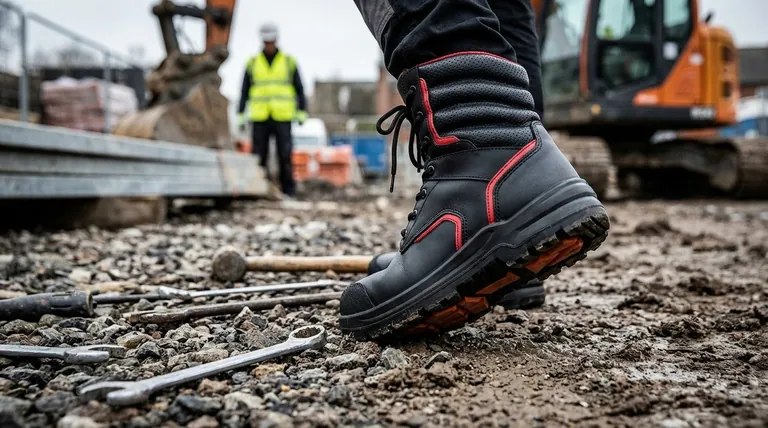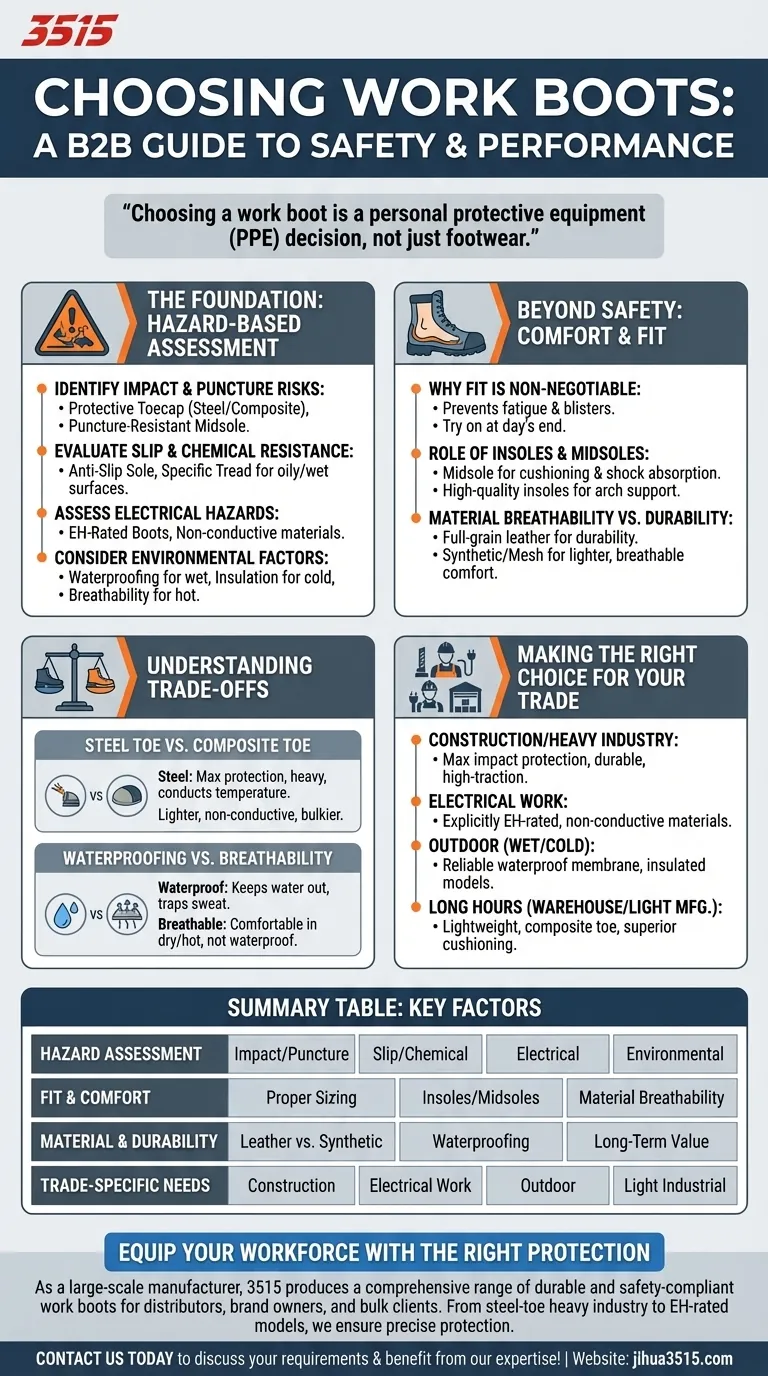When choosing work boots, the most critical factors are the specific safety hazards of your job, a proper fit that ensures all-day comfort, and durable materials designed for your work environment. These elements must take precedence over aesthetics or price to guarantee protection and performance.
Choosing a work boot is not a footwear decision; it's a personal protective equipment (PPE) decision. The right choice begins with a clear understanding of your workplace hazards, as this dictates every other feature you need.

The Foundation: A Hazard-Based Assessment
Before considering any boot, you must first analyze the risks you face daily. This assessment, often required by employers, is the single most important step in the selection process.
Identifying Impact and Puncture Risks
Most industrial and construction jobs involve risks from falling objects or sharp items underfoot. Your boot's protective structure is the first line of defense.
Look for a protective toecap (steel or composite) to guard against impact and compression. For protection from below, a puncture-resistant midsole is essential to stop nails and other sharp objects.
Evaluating Slip and Chemical Resistance
Slips, trips, and falls are among the most common workplace injuries. The boot's outsole is your point of contact with the ground and is critical for stability.
Ensure the boot has an anti-slip sole with a tread pattern designed for the surfaces you work on, whether they are oily, wet, or uneven.
Assessing Electrical Hazards
For electricians or anyone working near live circuits, specialized footwear is non-negotiable.
Boots rated for Electrical Hazard (EH) are constructed with non-conductive materials to provide a secondary source of protection against electrocution.
Considering Environmental Factors
Your work environment extends beyond immediate mechanical or electrical dangers. Weather and climate play a significant role in comfort and safety.
Features like waterproofing are crucial for wet conditions, while insulation is necessary for cold climates. Conversely, in hot weather, a boot's breathability becomes a key factor for comfort.
Beyond Safety: Prioritizing All-Day Comfort and Fit
A safe boot is ineffective if it's too uncomfortable to wear correctly or for a full shift. Comfort is not a luxury; it is a component of safety and performance.
Why Fit is Non-Negotiable
An improperly fitting boot can cause fatigue, blisters, and pain, which can distract you and increase the risk of an accident.
Always try on boots at the end of the day when your feet are slightly swollen. Ensure there is enough room to wiggle your toes but that your heel does not slip while walking.
The Role of Insoles and Midsoles
The components inside the boot determine how it feels underfoot during a long day. The midsole provides cushioning and absorbs shock, reducing strain on your joints.
High-quality insoles offer arch support and can significantly enhance comfort. Many are removable, allowing you to use custom orthotics if needed.
Material Breathability vs. Durability
The materials used for the boot's upper affect its lifespan, flexibility, and comfort. Full-grain leather offers excellent durability and protection but can be heavy and require a break-in period.
Modern synthetic materials and mesh can provide a lighter, more breathable, and flexible alternative, often ideal for less abrasive environments or athletic-style work shoes.
Understanding the Trade-offs
Selecting the perfect work boot always involves balancing competing features. Understanding these compromises is key to making an informed decision.
Steel Toe vs. Composite Toe
Steel toes offer maximum protection but can be heavy and conduct heat and cold. Composite toes are lighter and don't conduct temperature, but they can be bulkier to achieve the same safety rating.
Waterproofing vs. Breathability
A fully waterproof membrane is excellent at keeping water out, but it can also trap sweat inside, leading to discomfort. A non-waterproof boot made of breathable materials will be more comfortable in dry, hot conditions.
Price vs. Long-Term Value
It can be tempting to choose a less expensive boot, but this often leads to a false economy. High-quality boots use better materials and construction methods, resulting in superior durability, comfort, and safety over the long term.
Making the Right Choice for Your Trade
Your final decision should be a direct reflection of your daily tasks and environment.
- If your primary focus is construction or heavy industry: Prioritize maximum impact protection with a steel toe, a puncture-resistant midsole, and a durable, high-traction outsole.
- If your primary focus is electrical work: Insist on an explicitly EH-rated boot made from non-conductive materials to ensure your safety.
- If your primary focus is outdoor work in wet or cold climates: Select a boot with a reliable waterproof membrane and consider an insulated model for warmth.
- If your primary focus is long hours on your feet in a warehouse or light manufacturing: Emphasize a lightweight design, such as a composite toe, and superior cushioning in the midsole and insole.
Investing in the right work boot is a direct investment in your personal safety, daily comfort, and professional performance.
Summary Table:
| Factor | Key Considerations |
|---|---|
| Hazard Assessment | Impact/Puncture, Slip/Chemical, Electrical, Environmental |
| Fit & Comfort | Proper Sizing, Insoles/Midsoles, Material Breathability |
| Material & Durability | Leather vs. Synthetic, Waterproofing, Long-Term Value |
| Trade-Specific Needs | Construction, Electrical Work, Outdoor, Light Industrial |
Ready to equip your workforce with the right protection?
As a large-scale manufacturer, 3515 produces a comprehensive range of durable and safety-compliant work boots for distributors, brand owners, and bulk clients. Our production capabilities encompass all types of safety footwear, from steel-toe boots for heavy industry to EH-rated models for electrical work, ensuring your team has the precise protection they need.
Contact us today to discuss your requirements and benefit from our manufacturing expertise!
Visual Guide

Related Products
- Premium Wholesale Waterproof Safety Boots High Performance Protection for Industrial Markets
- Customizable Anti-Smash Safety Boots for Wholesale & Private Label Manufacturing
- Premium Flame-Retardant Waterproof Safety Boots and Shoes
- Premium Grain Leather Safety Boots for Bulk Supply
- Wholesale Slip-On Safety Boots Manufacturer - Custom Puncture-Proof & Steel Toe
People Also Ask
- What is the primary purpose of safety shoes? Your Ultimate Guide to Workplace Foot Protection
- What is a safety-toe in a boot? Your Guide to Choosing the Right Protection
- How does routine boot maintenance benefit workplace safety? Proactive PPE Protection for Your Workforce
- What are some real-world examples of safety footwear preventing injuries? Protect Your Workforce Effectively
- What are the key considerations when choosing safety boots? Match Hazards to Features for Maximum Protection



















